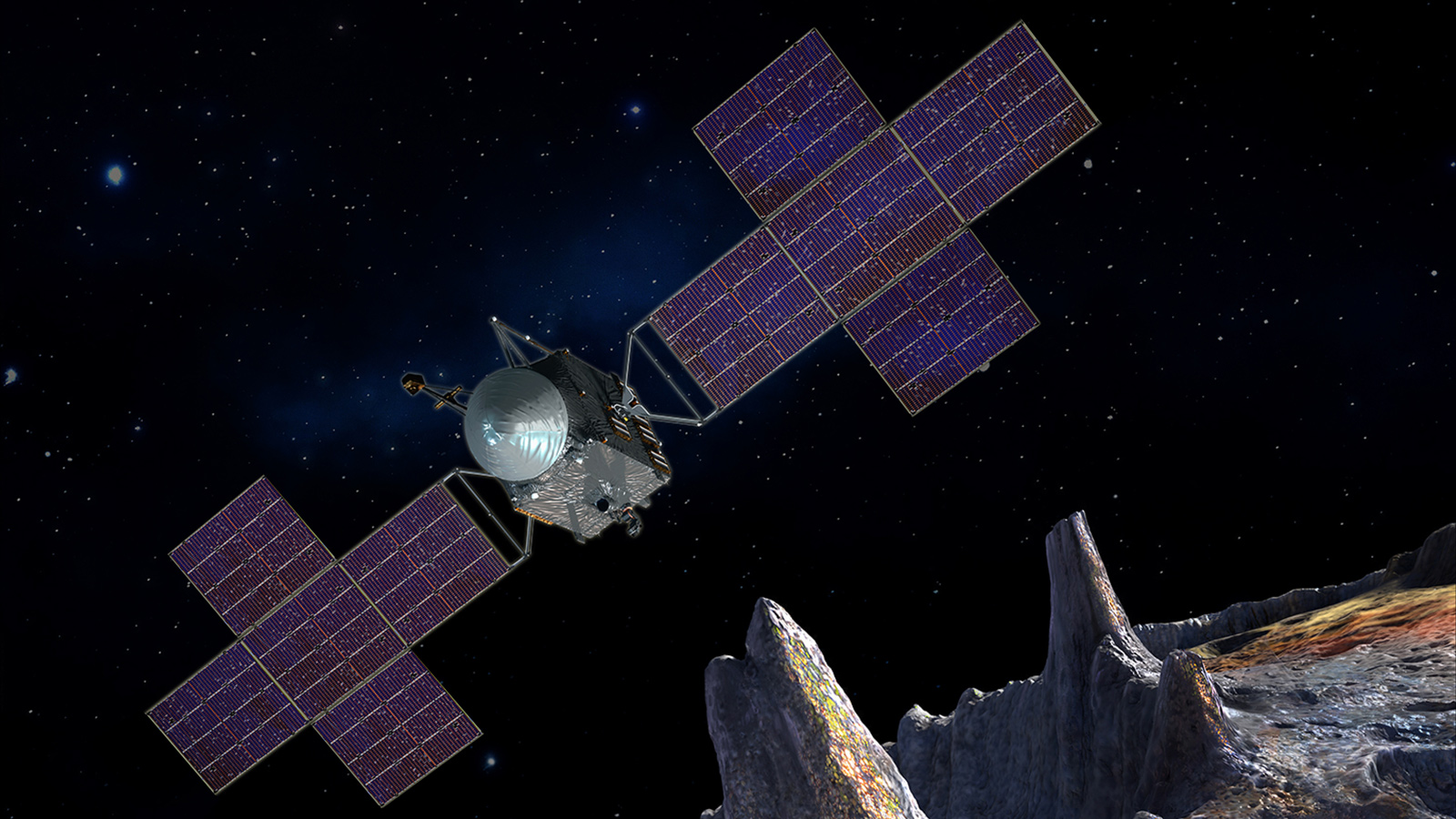
Metal Asteroid Psyche Is Ready for an Early Visit from NASA

This article was originally published at The Conversation. The publication contributed the article to Space.com's Expert Voices: Op-Ed & Insights.
Three times further away from the sun than the Earth lies an enormous lump of metal. Around 252km in diameter, the metallic "M-class" asteroid 16 Psyche is the target of NASA's next mission to the belt of giant rocks that encircles the inner solar system. And the space agency now plans to visit it much sooner than originally planned.
Not only has the launch has been brought forward one year to the summer of 2022, but NASA’s scientists have also found a way to get to Psyche (pronounced SYKe-ee) much faster by taking a more efficient trajectory. The new route means the Psyche spacecraft won’t have to swing around the Earth to build up speed and won’t pass as close to the sun, so it needs less heat protection. It is now due to arrive in 2026, four years earlier than the original timeline.
The main aim of the journey to Psyshe is to gather more information about our own solar system. Psyche is one of many wandering members of the asteroid belt. Unlike the rest of its rocky neighbours, Psyche appears to be entirely made of nickel and iron, just like the Earth’s core. This, together with its size, has led to the theory that it might be the remains of the inside of a planet.
Asteroids are made up of primitive materials, leftovers from the dust cloud from which our solar system originated. Different types of asteroids resemble the various steps it took to form planets from this dust cloud. This means they reveal a lot about the origin and evolution of our solar system. Scientists think Psyche could be what’s left of an exposed metal core of a planet very similar to Earth.
We actually derive much of our knowledge about asteroids and the evolution of planets from the study of meteorites. Many asteroids and comets are primitive protoplanetary bodies accumulated from the same dust cloud our solar system originates from. As these protoplanetary bodies collide, gravity pulls them together into ever-larger bodies. Eventually these bodies become big and hot enough to partially melt, allowing heavy materials such as iron to sink to the core – and lighter material such as silicon to rise to the surface.
This process, known as differentiation, explains why Earth and other planets such as Mercury, Venus or Mars have an iron core and silicon-rich mantle and crust. The 16 Psyche asteroid is thought to be the leftover iron core of a planet stripped of its mantle in a giant collision.
Get the Space.com Newsletter
Breaking space news, the latest updates on rocket launches, skywatching events and more!
But many questions regarding the formation of Psyche remain. How do you strip a planet of its mantle only leaving the core? Perhaps there is an alternative formation mechanism of an iron-rich body that does not involve differentiation? Psyche may once have been molten and, if so, did it cool from the inside out or from its surface to the core?
Also, Earth’s magnetic field comes from a liquid outer core circling around a solid inner core. Did these processes occur on Psyche and create a magnetic field? What elements other than iron accumulate in a core? And how does the surface geology of an iron body look compared to a rocky or icy body?

Avoiding collisions
There are other reasons for visiting asteroids. For one thing, possible collisions with Earth can have devastating effects. The impact of an 15km-wide asteroid approximately 65m years ago is linked to the extinction of the dinosaurs. And the explosion of the 30m-diameter Chelyabinsk asteroid over Russia in 2013 led to injuries and damage on the ground. We need to know as much as possible about the composition and physical make-up of asteroids to devise the best ways to defend our planet.
Asteroids also provide resources. Those containing water or other valuable materials may act as stepping stones for human exploration of the solar system. And asteroids crossing Earth’s orbit may become convenient targets for mining operations, providing materials that are running out on Earth and potentially taking environmentally detrimental extraction methods off Earth. Companies including Planetary Resources and countries like Luxembourg have already started to pursue these ideas in earnest.
The Psyche spacecraft will carry four instruments to gather as much information about the asteroid as it can: a camera, a gamma-ray spectrometer to record what chemical elements are there, a magnetometer, and a radio gravity experiment. The data these devices collect should help us work out if Psyche is the frozen core of a former planet or simply a lump of unmelted metal. If it is a core, then it might help us determine exactly what’s at the centre of our own planet.
Lindy Elkins-Tanton, the lead scientist of the mission, probably summarised it best: “We learn about inner space by visiting outer space”.
Christian Schroeder, Senior Lecturer in Environmental Science and Planetary Exploration, University of Stirling
This article was originally published on The Conversation. Read the original article. Follow all of the Expert Voices issues and debates — and become part of the discussion — on Facebook, Twitter and Google +. The views expressed are those of the author and do not necessarily reflect the views of the publisher. This version of the article was originally published on Space.com.
Join our Space Forums to keep talking space on the latest missions, night sky and more! And if you have a news tip, correction or comment, let us know at: community@space.com.









